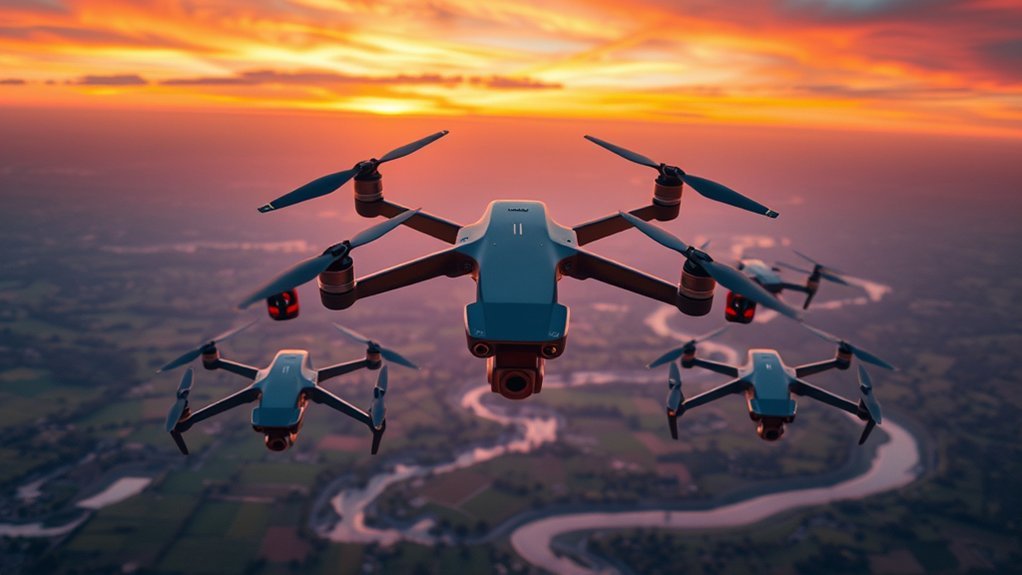When it comes to capturing breathtaking aerial shots, exploring innovative technology, and taking your photography to new heights, the best drones in 2025 are essential tools. The DJI Mini 3, Ruko F11PRO 2, and others stand out with their impressive features and capabilities. Which one will suit your needs and skill level? Let’s take a closer look at these top contenders and how they can transform your aerial photography experience.
DJI Mini 3 Drone with Camera (DJI RC)
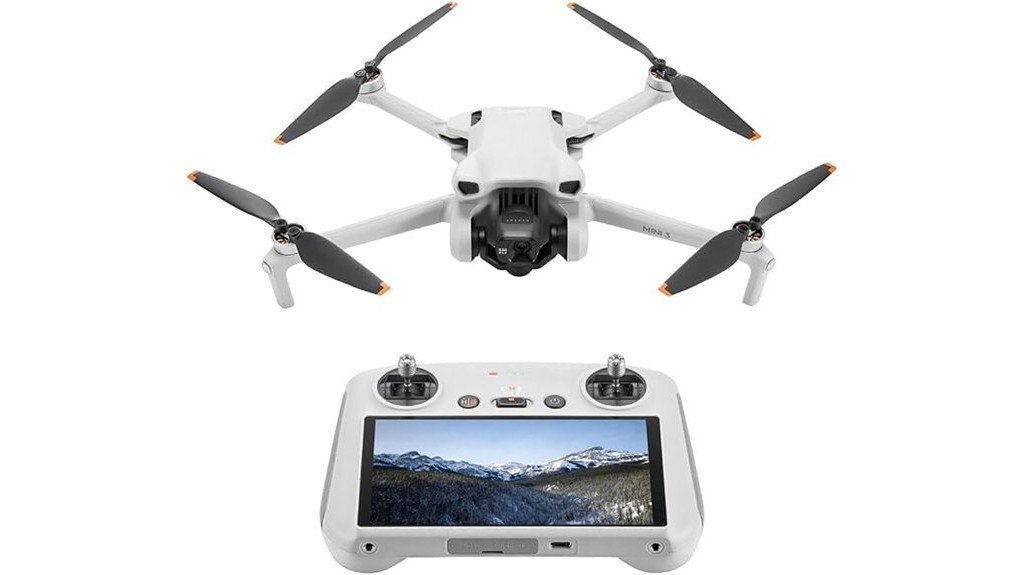
If you’re a photography enthusiast looking for a lightweight and easy-to-use drone, the DJI Mini 3 is an excellent choice. Weighing just 248 grams, it doesn’t require FAA registration for recreational use. With a remarkable flight time of up to 38 minutes and advanced features like a 3-axis mechanical gimbal, you’ll capture stunning 4K UHD videos effortlessly. Its True Vertical Shooting mode makes social media posting a breeze, while the wind resistance of up to 38 kph guarantees stable flights. The DJI Mini 3’s portability and ease of use make it perfect for both beginners and seasoned aerial photographers.
Best For: Photography enthusiasts and beginners seeking a lightweight, user-friendly drone for stunning aerial shots.
Pros:
- Excellent 4K UHD video quality with Dual Native ISO for low-light conditions.
- Lightweight design (248 grams) allows for easy transport and eliminates the need for FAA registration.
- Impressive flight time of up to 38 minutes, extendable with additional battery swaps.
Cons:
- Limited wind resistance may affect performance in stronger winds.
- Activation required via DJI Fly App, which may not be user-friendly for everyone.
- Additional Intelligent Flight Battery Plus sold separately for extended flight time.
DJI Mini Drone with 4K UHD Camera
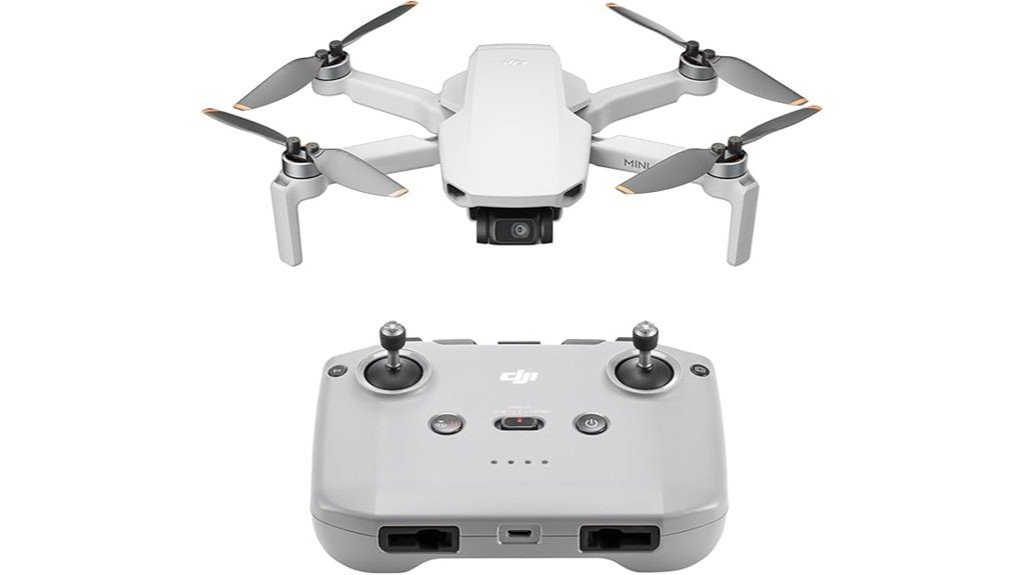
The DJI Mini Drone with its impressive 4K UHD camera is perfect for aspiring aerial photographers who want high-quality shots without the hassle of complex setups. Weighing under 249 g, you won’t need FAA registration, making it incredibly convenient. With a wind resistance of up to 38kph and an altitude capability of 4,000 meters, you can capture stunning footage in various conditions. The 3-axis gimbal guarantees cinematic stabilization, while intelligent flight modes like QuickShots simplify the process. Plus, with up to 93 minutes of combined flight time and GPS Return to Home, you can focus on creativity without stress.
Best For: Aerial photography enthusiasts and beginners looking for a user-friendly drone that delivers high-quality visuals without the need for complex setups.
Pros:
- Compact and lightweight design that eliminates the need for FAA registration.
- Impressive 4K UHD camera paired with a 3-axis gimbal for stable, cinematic footage.
- Easy-to-use features like one-tap takeoff and intelligent flight modes for effortless operation.
Cons:
- Limited battery life with a maximum of 31 minutes per battery, requiring additional purchases for extended use.
- Wind resistance may not be sufficient for very windy conditions, limiting flight options.
- No advanced obstacle avoidance technology, which could make flying in complex environments riskier.
Ruko F11PRO 2 Drone with 6K Camera
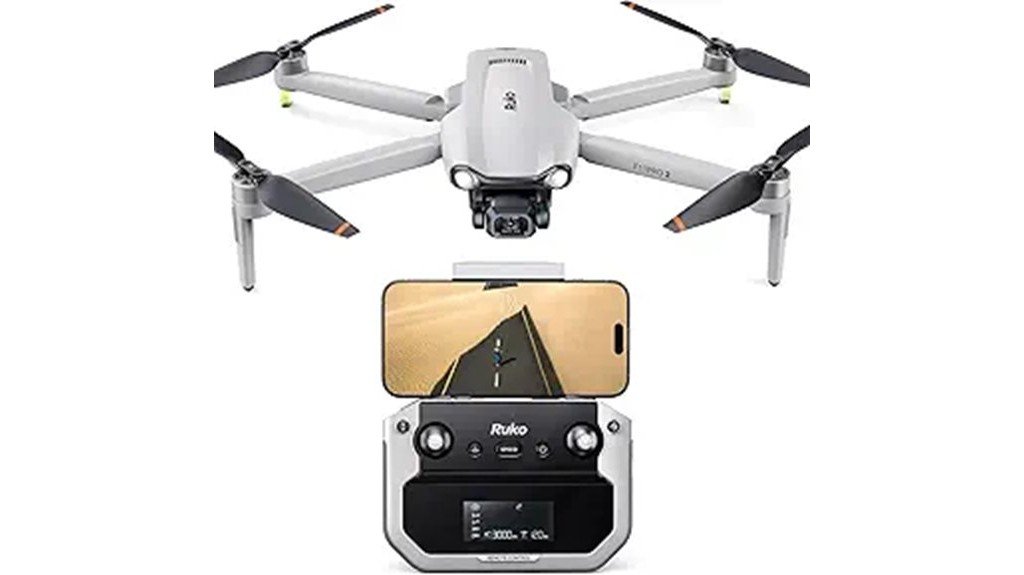
Looking to elevate your aerial photography game? The Ruko F11PRO 2 Drone with its impressive 6K camera is your go-to choice. Capture stunning images and 4K videos at 30fps, showcasing vibrant colors and exceptional clarity. Its 3-axis brushless gimbal guarantees smooth, stable shots, even in windy conditions. With two batteries providing up to 70 minutes of flight time, you can explore more. Plus, intelligent GPS modes like follow-me and waypoint planning simplify operation, making it beginner-friendly. Whether it’s backyard BBQs or kids’ bike rides, turn everyday moments into cinematic treasures with this remarkable drone.
Best For: Aerial photography enthusiasts and families looking to capture high-quality moments with ease.
Pros:
- High-resolution 6K camera for stunning photo and video quality.
- User-friendly intelligent flight modes that cater to beginners.
- Long flight time of up to 70 minutes with two batteries for extended exploration.
Cons:
- Requires Ruko charger for optimal performance, limiting charging options.
- Performance may be affected in extreme weather conditions despite enhanced wind resistance.
- Advanced features may require some learning curve for complete beginners.
Ruko U11MINI 4K Drone with Camera for Adults

Discover the Ruko U11MINI 4K Drone, a standout choice for aerial photography enthusiasts seeking high-quality imaging without breaking the bank. Weighing under 249g, it’s FAA-exempt and boasts impressive 4K video and 8K photo capabilities. With a total flight time of 96 minutes from three batteries and a 20,000ft transmission range, you’ll capture stunning views effortlessly. Its 3-axis gimbal and EIS guarantee smooth footage, while beginner-friendly controls make it accessible for all skill levels. The Ruko U11MINI also includes safety features like auto-return and adjustable return points, making it a reliable companion for your aerial adventures.
Best For: Aerial photography enthusiasts and beginners looking for a high-quality drone that is easy to use and offers excellent value for money.
Pros:
- High-quality 4K video and 8K photo capabilities with stabilization features.
- Long flight time of 96 minutes with three included batteries.
- User-friendly controls and safety features, making it ideal for beginners.
Cons:
- Some users report issues with camera stabilization without a dedicated gimbal.
- Battery life may not meet the expectations of all users.
- Occasional shakiness in footage under certain conditions.
Bwine F7 Pro Drone with Camera for Adults
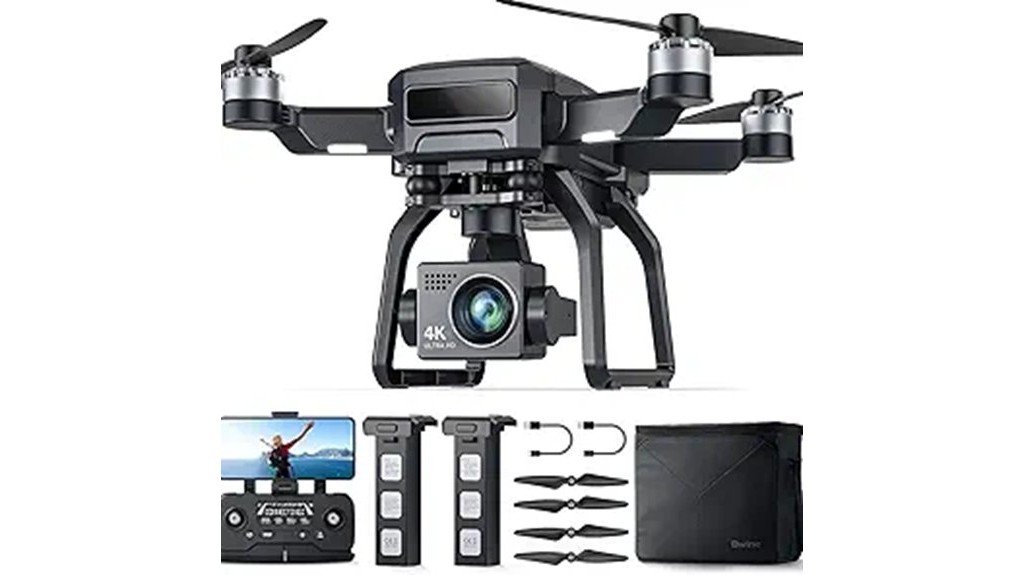
For anyone seeking a versatile and high-performing drone for aerial photography, the Bwine F7 Pro stands out with its impressive 4K UHD camera and advanced 3-axis gimbal stabilization. You’ll enjoy a 50-minute flight time with two intelligent batteries, allowing you to capture stunning shots from up to 10,000 feet away. Its adjustable wide-angle lens offers a 90° to 120° field of view, while the 5x digital zoom enhances your creative options. With GPS features like Auto Return and Follow Me, you can fly confidently. Weighing just 550 grams, it’s perfect for both beginners and seasoned photographers.
Best For: The Bwine F7 Pro Drone is best for aerial photography enthusiasts and beginners looking for a user-friendly drone with advanced features.
Pros:
- High-quality 4K UHD camera with advanced 3-axis gimbal for stable imaging and stunning aerial shots.
- Long flight time of 50 minutes with two intelligent batteries, allowing for extended shooting sessions.
- User-friendly GPS features like Auto Return and Follow Me, enhancing safety and ease of use for beginners.
Cons:
- Long charging time of approximately 6.5 hours, which may limit usage between flights.
- Weight of 550 grams might be considered heavy for some users, affecting portability.
- Limited zoom capability with only 5x digital zoom, which may not satisfy more advanced photographers seeking higher zoom options.
Factors to Consider When Choosing a Drone for Aerial Photography
When you’re choosing a drone for aerial photography, several key factors come into play. You’ll want to take into account camera quality, flight time, and stability features to guarantee you capture stunning images. Don’t forget about portability and user-friendly controls, as these can make or break your flying experience.
Camera Quality Matters
Camera quality plays a pivotal role in aerial photography, influencing the clarity and vibrancy of your images. When choosing a drone, look for high-resolution cameras that offer 4K UHD or higher; these capture intricate details and vibrant colors. A larger sensor, like a 1/2-inch CMOS, excels in low-light conditions, perfect for those stunning sunrise or sunset shots. Advanced stabilization features, such as a 3-axis gimbal, reduce motion blur, ensuring steady footage even in windy weather. Enhanced zoom capabilities give you the flexibility to frame shots from a distance without losing quality. Finally, dual native ISO settings help you adapt to varying lighting conditions, allowing you to capture high-quality imagery at any time of day.
Flight Time Considerations
Flight time is an essential factor to take into account in aerial photography, as longer durations let you capture more footage without interruptions. Some models offer up to 51 minutes of flight time, especially with extended battery options. Consider drones equipped with intelligent battery management systems for enhanced flight duration and safe return-to-home features, which are crucial during longer sessions. Having multiple battery options can considerably boost your total shooting time; some setups achieve up to 114 minutes through battery swaps. Keep in mind that factors like wind resistance can impact flight time, so look for drones rated for stability in adverse conditions. Always check the manufacturer’s specifications for expected flight times under normal conditions for accurate expectations.
Stability and Gimbal Features
To capture stunning aerial photographs, you need a drone that excels in stability and gimbal features. A 3-axis gimbal is essential, as it stabilizes the camera during flight, minimizing vibrations for smooth, cinematic-quality footage. Look for drones with higher wind resistance ratings, like Level 5 or 6, to guarantee stability in breezy conditions. Intelligent flight features, such as GPS-based auto return and follow-me modes, can help maintain your drone’s position and orientation automatically. Also, consider the weight of the drone; heavier models generally perform better in turbulence. Advanced stabilization technologies, like Electronic Image Stabilization (EIS), further enhance video quality by compensating for minor shakes, ensuring your aerial shots are always impressive.
Portability and Weight
When selecting a drone for aerial photography, portability and weight play crucial roles in your decision-making process. Drones weighing under 249 grams are often exempt from FAA registration, making them easier to transport. Look for compact and foldable designs that enhance portability, allowing you to store and carry your drone effortlessly to various shooting locations. Lightweight drones also experience less wind resistance, ensuring better stability during flight, which leads to more reliable image capture. Additionally, a lighter drone can improve battery performance, offering longer flight times for capturing extended aerial shots. Prioritizing portability and weight will make your photography adventures more enjoyable and successful.
User-Friendly Controls
Choosing a drone with user-friendly controls can make your aerial photography experience much smoother, especially if you’re a beginner. Look for features like one-tap takeoff and landing to simplify flying. An intuitive interface and app integration can provide in-app tutorials, helping you quickly learn the ropes. Safety is vital, so consider drones with automatic return-to-home (RTH) features, ensuring the drone returns if the battery runs low or the signal gets lost. Drones equipped with advanced GPS systems help you achieve stable hovering and easier navigation, essential for capturing precise aerial shots. Finally, models offering multiple flight modes—beginner, cine, and sport—cater to various skill levels and creative filming needs, enhancing your overall experience.
Intelligent Flight Modes
Many photographers find that intelligent flight modes greatly enhance their aerial photography experience. These modes, like QuickShots and automated waypoint planning, let you capture professional-level footage with minimal effort, boosting your creativity and efficiency. Features such as Follow Me and Orbit Flight allow your drone to autonomously track subjects or circle them, providing dynamic perspectives without needing constant control. If you’re a beginner, advanced drones often include pre-programmed maneuvers that simplify complex shots, making it easy to achieve cinematic results. Plus, many drones offer multiple flight modes tailored for different environments, accommodating various skill levels. With integrated GPS technology, these modes guarantee stable hovering and accurate navigation, improving the safety and reliability of your aerial photography sessions.
Battery Life and Management
Battery life is one of the most critical factors to evaluate for aerial photography, as it directly impacts your ability to capture stunning images. Longer flight times, like those reaching up to 96 minutes with multiple batteries, give you more opportunities to get that perfect shot. Look for drones with intelligent battery management systems; these enhance safety with low battery alerts and automatic return-to-home features. Keep in mind that battery capacity, measured in milliamp hours (mAh), influences flight duration—larger capacities usually mean longer flights. Environmental factors, such as wind and temperature, can affect performance, so plan accordingly. Additionally, consider extended battery packs for more extensive sessions, reducing the need for frequent landings to swap batteries.
